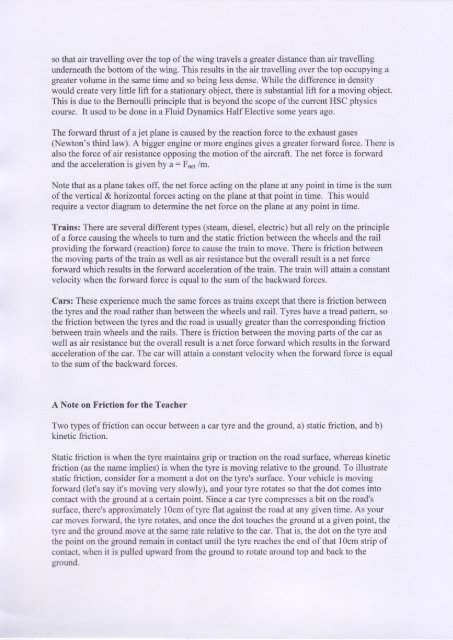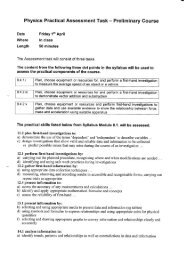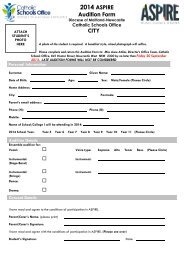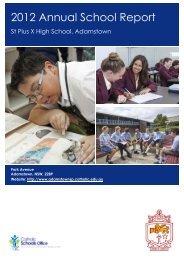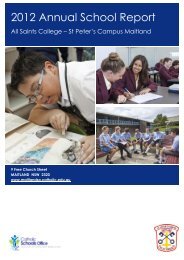Solutions to Force - Worksheet 1
Solutions to Force - Worksheet 1
Solutions to Force - Worksheet 1
Create successful ePaper yourself
Turn your PDF publications into a flip-book with our unique Google optimized e-Paper software.
so that air travelling over the <strong>to</strong>p of the wing travels a greater distance than air travelling<br />
underneath the bot<strong>to</strong>m of the wing. This results in the air travelling over the <strong>to</strong>p occupying a<br />
greater volume in the same time and so being less dense. While the difference in density<br />
would create very little lift for a stationary object, there is substantialift for a moving object.<br />
This is due <strong>to</strong> the Bernoulli principle that is beyond the scope of the current HSC physics<br />
course. It used <strong>to</strong> be done in a Fluid Dynamics Half Elective some years ago.<br />
The forward thrust of a jet plane is caused by the reaction force <strong>to</strong> the exhaust gases<br />
(New<strong>to</strong>n's third law). A bigger engine or more engines gives a greater forward force. There is<br />
also the force of air resistance opposing the motion of the airqaft. The net force is forward<br />
and the acceleration is given by a: Fn.1 /m.<br />
Note that as a plane takes off, the net force acting on the plane at any point in time is the sum<br />
of the vertical &horizontal forces acting on the plane atthatpoint in time. This would<br />
require a vec<strong>to</strong>r diagram <strong>to</strong> determine the net force on the plane at any point in time.<br />
Trains: There are several different types (steam, diesel, electric) but all rely on the principle<br />
of a force causing the wheels <strong>to</strong> turn and the static friction between the wheels and the rail<br />
providing the forward (reaction) force <strong>to</strong> cause the train <strong>to</strong> move. There is friction between<br />
the moving parts of the train as well as air resistance but the overall result is a net force<br />
forward which results in the forward acceleration of the train. The train will attain a constant<br />
velocity when the forward force is equal <strong>to</strong> the sum of the backward forces.<br />
Cars: These experience much the same forces as trains except that there is friction between<br />
the tyres and the road rather than between the wheels and rail. Tyres have atread pattern, so<br />
the friction between the tyres and the road is usually greater than the corresponding friction<br />
between train wheels and the rails. There is friction between the moving parts of the car as<br />
well as air resistance but the overall result is a net force forward which results in the forward<br />
acceleration of the car. The car will attain a constant velocitv when the forward force is equal<br />
<strong>to</strong> the sum of the backward forces.<br />
A Note on Friction for the Teacher<br />
Two types of friction can occur between a car tyre and the ground, a) static friction, and b)<br />
kinetic friction.<br />
Static friction is when the tyre maintains grip or traction on the road surface, whereas kinetic<br />
friction (as the name implies) is when the tyre is moving relative <strong>to</strong> the ground. To illustrate<br />
static friction, consider for a moment a dot on the tyre's surface. Your vehicle is moving<br />
forward (let's say it's moving very slowly), and your tyre rotates so that the dot comes in<strong>to</strong><br />
contact with the ground at a certain point. Since a car tyre compresses a bit on the road's<br />
surface, there's approximately lOcm of tyre flat againsthe road at any given time. As your<br />
car moves forward, the tyre rotates, and once the dot <strong>to</strong>uches the ground at a given point, the<br />
tyre and the ground move at the same rate relative <strong>to</strong> the car. That is, the dot on the tyre and<br />
the point on the ground remain in contact until the tyre reaches the end of that 10cm strip of<br />
contact, when it is pulled upward from the ground <strong>to</strong> rotate around <strong>to</strong>p and back <strong>to</strong> the<br />
ground.


